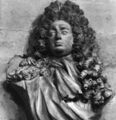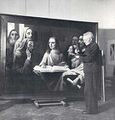Template:Selected anniversaries/October 10: Difference between revisions
No edit summary |
No edit summary |
||
| Line 1: | Line 1: | ||
<gallery> | <gallery> | ||
||Bernardino Baldi | ||1617: Bernardino Baldi dies ... mathematician and writer. Pic. | ||
||1629 | ||1629: Richard Towneley born ... mathematician and astronomer. | ||
File:David Gregory.jpg|link=David Gregory (nonfiction)|1708: Mathematician and astronomer [[David Gregory (nonfiction)|David Gregory]] dies. At the Union of 1707, he was given the responsibility of reorganizing the Scottish Mint. | File:David Gregory.jpg|link=David Gregory (nonfiction)|1708: Mathematician and astronomer [[David Gregory (nonfiction)|David Gregory]] dies. At the Union of 1707, he was given the responsibility of reorganizing the Scottish Mint. | ||
| Line 11: | Line 11: | ||
File:Henry Cavendish.jpg|link=Henry Cavendish (nonfiction)|1731: Chemist, physicist, and philosopher [[Henry Cavendish (nonfiction)|Henry Cavendish]] born. He will discover "inflammable air", later named hydrogen. | File:Henry Cavendish.jpg|link=Henry Cavendish (nonfiction)|1731: Chemist, physicist, and philosopher [[Henry Cavendish (nonfiction)|Henry Cavendish]] born. He will discover "inflammable air", later named hydrogen. | ||
||1837 | ||1837: Charles Fourier dies ... philosopher and academic. | ||
||1846 | ||1846: Astronomer William Lassell discovers Triton, the largest moon of the planet Neptune. | ||
||1861 | ||1861: Fridtjof Nansen born ... explorer, scientist, and humanitarian, Nobel Prize laureate. | ||
||1770: Benjamin Wright born ... engineer who directed the construction of the Erie Canal. A one-time judge, he helped survey the Erie Canal route. When the Erie Canal was finally funded in 1817, Wright was selected as one of the three engineers to design and build it, then named chief engineer. Wright made the Erie Canal project a school of engineering. Until mid-century, almost every civil engineer in the U.S. had trained with, or been trained by someone who had worked under, Wright on the Erie Canal. Because he trained so many engineers on that project, Wright has been called the “father of American civil engineering.” He also engaged in the design and construction at the outset of the first railroads. He was the first Chief Engineer of the Erie Railroad. Pic. | ||1770: Benjamin Wright born ... engineer who directed the construction of the Erie Canal. A one-time judge, he helped survey the Erie Canal route. When the Erie Canal was finally funded in 1817, Wright was selected as one of the three engineers to design and build it, then named chief engineer. Wright made the Erie Canal project a school of engineering. Until mid-century, almost every civil engineer in the U.S. had trained with, or been trained by someone who had worked under, Wright on the Erie Canal. Because he trained so many engineers on that project, Wright has been called the “father of American civil engineering.” He also engaged in the design and construction at the outset of the first railroads. He was the first Chief Engineer of the Erie Railroad. Pic. | ||
| Line 23: | Line 23: | ||
File:Van meegeren trial.jpg|link=Han van Meegeren (nonfiction)|1889: Painter and forger [[Han van Meegeren (nonfiction)|Han van Meegeren]] born. He will be one of the most ingenious art forgers of the 20th century. | File:Van meegeren trial.jpg|link=Han van Meegeren (nonfiction)|1889: Painter and forger [[Han van Meegeren (nonfiction)|Han van Meegeren]] born. He will be one of the most ingenious art forgers of the 20th century. | ||
||1897 | ||1897: Chemist Felix Hoffmann discovers an improved way of synthesizing acetylsalicylic acid (aspirin). | ||
||1919: Arvid Gerhard Damm files for a patent (Swedish patent #52,279) on a rotor machine | ||1919: Arvid Gerhard Damm files for a patent (Swedish patent #52,279) on a rotor machine | ||
||Pierre Dolbeault | ||1924: Pierre Dolbeault born ... mathematician. | ||
||1927 | ||1927: Gustave Whitehead dies ... pilot and engineer. | ||
||Elijah J. McCoy | ||1929: Elijah J. McCoy dies ... inventor and engineer who was notable for his 57 U.S. patents, most having to do with the lubrication of steam engines. | ||
||1930 | ||1930: Yves Chauvin born ... chemist and academic, Nobel Prize laureate. | ||
||1936 | ||1936: Gerhard Ertl, German physicist and chemist, Nobel Prize laureate (alive August 2018). | ||
File:Janet Beta Accepts Commission (detail).jpg|link=Janet Beta|1943: Mathematician and soldier [[Janet Beta]] accepts commission with secret military-intelligence program [[ENIAC (SETI)|ENIAC]]. | File:Janet Beta Accepts Commission (detail).jpg|link=Janet Beta|1943: Mathematician and soldier [[Janet Beta]] accepts commission with secret military-intelligence program [[ENIAC (SETI)|ENIAC]]. | ||
||1949 | ||1949: Chikuhei Nakajima dies ... engineer, businessman, and politician, founded Nakajima Aircraft Company. | ||
|File:Chrome Plover early publicity photo.jpg|link=Chrome Plover|1959: [[Chrome Plover]], the famous [[musical electroplating ensemble]], announces new tour. | |File:Chrome Plover early publicity photo.jpg|link=Chrome Plover|1959: [[Chrome Plover]], the famous [[musical electroplating ensemble]], announces new tour. | ||
||1963 | ||1963: France cedes control of the Bizerte naval base to Tunisia. | ||
||1963 | ||1963: The Partial Nuclear Test Ban Treaty comes into effect. | ||
||1964 | ||1964: The opening ceremony of the 1964 Summer Olympics in Tokyo, Japan, is broadcast live in the first Olympic telecast relayed by geostationary satellite. | ||
||1967 | ||1967: The Outer Space Treaty is signed on January 27 by more than sixty nations. | ||
|| | ||1971: Cyril Lodowic Burt dies ... educational psychologist and geneticist who made contributions also to statistics. He is known for his studies on the heritability of IQ. Shortly after he died, his studies of inheritance and intelligence were discredited after evidence emerged indicating he had falsified research data. Pic. | ||
||Heinrich Adolph Louis Behnke (d. 10 October 1979) was a German mathematician | ||1979: Heinrich Adolph Louis Behnke (d. 10 October 1979) was a German mathematician | ||
||1979 | ||1979: Christopher Evans dies ... psychologist, computer scientist, and author. | ||
||1986 | ||1986: Gleb Wataghin dies ... physicist and academic. | ||
||Juan Pujol García | ||1988: Juan Pujol García dies ... Spanish citizen who deliberately became a double agent against Nazi Germany during World War II. He relocated to England to carry out fictional spying activities for the Nazis, and was known by the British codename Garbo and the German codename Alaric Arabel. Pic. | ||
||1997 | ||1997: Michael J. S. Dewar dies ... American theoretical chemist who developed the Dewar-Chatt-Duncanson model. | ||
||Konstantin Petrzhak | ||1998: Konstantin Petrzhak dies ... nuclear physicist and university professor of Polish origin. He discovered spontaneous fission of uranium with Georgy Flyorov in 1940; in addition, he also aided in Soviet Union's atomic bomb project. | ||
||1998: William Markowitz dies ... astronomer, principally known for his work on the standardization of time. Pic: https://aas.org/obituaries/william-markowitz-1907-1998 | ||1998: William Markowitz dies ... astronomer, principally known for his work on the standardization of time. Pic: https://aas.org/obituaries/william-markowitz-1907-1998 | ||
|| | ||2007: Karl W. Gruenberg dies ... mathematician who specialized in group theory, in particular with the cohomology theory of groups. Pic. | ||
||2015 | ||2014: Ichirō Satake dies ... mathematician working on algebraic groups who introduced the Satake isomorphism and Satake diagrams. Pic. | ||
||2015: Richard F. Heck dies ... chemist and academic, Nobel Prize laureate. | |||
File:Zero knowledge proof.png|link=Zero-knowledge proof (nonfiction)|2014: Advances in [[Zero-knowledge proof (nonfiction)|zero-knowledge proof]] theory "are central to the problem of mathematical reliability," says mathematician and crime-fighter [[Alice Beta]]. | File:Zero knowledge proof.png|link=Zero-knowledge proof (nonfiction)|2014: Advances in [[Zero-knowledge proof (nonfiction)|zero-knowledge proof]] theory "are central to the problem of mathematical reliability," says mathematician and crime-fighter [[Alice Beta]]. | ||
</gallery> | </gallery> | ||
Revision as of 16:12, 25 August 2018
1708: Mathematician and astronomer David Gregory dies. At the Union of 1707, he was given the responsibility of reorganizing the Scottish Mint.
1730: Physicist and crime-fighter Daniel Gabriel Fahrenheit uses precision thermometry to detect and prevent crimes against mathematical constants.
1731: Chemist, physicist, and philosopher Henry Cavendish born. He will discover "inflammable air", later named hydrogen.
1888: Steganographic analysis of Alice Beta and Niles Cartouchian Play Chess reveals two terabytes of encrypted data.
1889: Painter and forger Han van Meegeren born. He will be one of the most ingenious art forgers of the 20th century.
1943: Mathematician and soldier Janet Beta accepts commission with secret military-intelligence program ENIAC.
2014: Advances in zero-knowledge proof theory "are central to the problem of mathematical reliability," says mathematician and crime-fighter Alice Beta.





